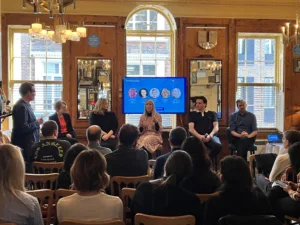The intersection of data and technology will be key to overcoming the digital advertising challenges of the coming years. Artificial intelligence (AI) will play a big role in this future, and will be key to making the industry operate more effectively and efficiently, but how will it all fit together in the privacy-first world?
In the second part of NDA’s roundtable, in partnership with Scibids, a group of industry experts share their thoughts on the role of data and AI in digital advertising. Participants include Joseph Lee, Media Activation Partner, Essence; Zuzanna Gierlinska, Managing Director, Xaxis UK; Nathan Taylor-Billings, Head of Activation, Matterkind UK&I; Dan Bigmore, Senior Director, Solutions Consultancy, The Trade Desk; Eldon Cate, Digital Client Lead, Starcom; Michelle Sarpong, Head of Display & Audio Activation, the7stars; and Matt Nash, UK MD, Scibids.
As we continue to slowly edge into a digital advertising world of fewer identifiers, and an increased focus on privacy and consent, questions around what to do with less access to third-party data aren’t going anywhere any time soon. Advertisers are seeking solutions, but are yet to find all of the answers.
“Identity – people are over that. That’s what you hear when you talk to senior clients. There’s also the fact that a lot of it doesn’t work in social. A lot of the stuff we’ve been looking at is around how you can take a step back, so that people understand it. And, also, maybe embrace the fact that some things are closed off behind walled gardens. A bit more modelling is probably something we’re going to have to live with,” suggested Starcom’s Cate.
“Where there are identifiers, it’s obviously much better for transparency and being able to attribute results. But you can no longer see, in all the channels, who the people are at the door or at the window. You can no longer identify them, so you have to find some other way of looking at the correlation between the two.”
Forming close data relationships
A big part of the future of digital advertising is going to come down to first-party data on both the buy side and the supply side.
Matterkind UK&I’s Taylor-Billings believes that “especially big advertisers” should be placing money into acquiring first-party data for multiple reasons. He said: “From a programmatic standpoint, alongside privacy regulations and the demise of the third-party cookie, it’s also about media wastage. We don’t want to bombard you with ads to ‘sign up’ if you’re already a customer of that brand, for example.”
“What can be challenging is brands understanding the need for first party data, but being reluctant to invest in the initial implementation. Another challenge is sometimes around their existing data teams, and the mismatch in what they need, versus what they think they need.”
the7stars’ Sarpong agrees with the importance of investing in this first-party data, pointing to some recent moves that have highlighted this.
“Suppliers with rich first-party data are starting to think about how they can use it more effectively in terms of their responses to brief, and in terms of who they partner with as well. Who can you partner with to bolster your data capabilities? A lot of suppliers are looking to see who they can partner with to gain that mass reach and data,” said Sarpong.
“Looking at Taboola’s partnership with Yahoo, for instance, goes to show the consolidation that’s happening a lot more across different suppliers just to gain that bigger market share and data pool that they can utilise.”
However, despite first-party data being “a really rich data source”, its lack of availability and scalability means that it’s equally important to look for alternative, sometimes simpler, solutions, according to Gierlinska of Xaxis.
Pointing to a recent successful geotargeted campaign for Cancer Research, Gierlinska said: “We’ve run quite a few of these campaigns for pretty big brands, and it’s shown us that there is a big appetite for the simplicity of going back to something that everybody understands. Most of these identity solutions don’t traverse across multiple channels. But something like geo can be used across every environment.
“As an industry, we need to go back to having more uniformity because, otherwise, the danger is we will become so specialised in all these different little areas that it fragments the actual impact.”
Intelligent data application
Though a combination of various data points – from first-party to contextual – are key to any advertising strategy in the privacy-first world, AI is just as important to being able to unlock the full value of all of this data. In particular, customisable AI.
“When you talk about bringing in more data to be more efficient and drive more performance, there’s nothing wrong with bringing on different artificial intelligence to assist there. That potentially frees up time for other tasks to empower better creative and planning,” The Trade Desk’s Bigmore explained. “It shifts the way we spend time to be using really smart technology in the best possible capacity. That’s why these pieces of software are built on top of APIs, and that’s why they are customisable. It’s to give the power to do the best thing you can with it.”
The ability to use customisable AI tools comes from the advanced features being delivered by DSPs, and Scibids’ Nash believes that “in short order all eligible campaigns will use the more sophisticated features the DSPs have made available.
“I even see the DSPs in print now saying that using the DSPs’ off the shelf capability is not enough anymore, you need to be using the more customised features. And it’s not just about bidding algorithms, there are other parts of the puzzle as well. But, within short order, if you’re not doing that, then the clients will start to ask why. So, it will become that hygiene factor.”
On the other hand, while praising the role of customisable AI, Essence’s Lee warned that utilising the technology can’t come at the detriment of the other elements of a campaign.
“I have seen campaigns propped up by AI and the algorithms, and it delivering performance, but everything else around it was unfortunately flawed,” said Lee. “We’ve got to be brave enough to have that conversation with our clients, because you can’t just have the algorithm dragging everything through.”









